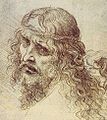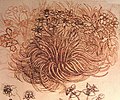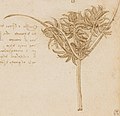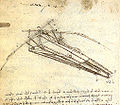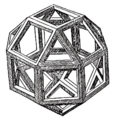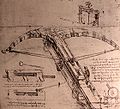User:Scriberius/Projects/Drawings of Leonardo da Vinci
| This is a Wikipedia user page. This is not an encyclopedia article or the talk page for an encyclopedia article. If you find this page on any site other than Wikipedia, you are viewing a mirror site. Be aware that the page may be outdated and that the user in whose space this page is located may have no personal affiliation with any site other than Wikipedia. The original page is located at https://en.wikipedia.org/wiki/User:Scriberius/Projects/Drawings_of_Leonardo_da_Vinci. |
|
Drawings by | |
| Gallery 2 (motifs) | |
| Gallery 1 (alphabet) | Gallery 3 (time) |
|
Drawings by | |
| Main index | Gallery 2 (motifs) |
| Gallery 1 (alphabet) | Gallery 3 (time) |
The List of drawings by Leonardo da Vinci gives a broad selection yet incomplete overwiew of the drawings by Tuscan polymath (architect, musician, anatomist, inventor, engineer, sculptor, geometer, and painter) Leonardo da Vinci (1452 – 1519) who made several hundred drawings during the Italian Renaissance. He had drawn portraits, objects, human anatomy, diagrams, animals, movements, and his inventions/ideas (each fictional and/or real). Most of his work are sketches and studies, some were preparations for his paintings. Leonardos drawings are considered as the first modern medical illustrations, too. Some paintings depict his dissections of human bodies.[1]
Far from being just a wild enthusiast making notes about everything possible, Leonardo is surprisingly specialized in his studies. Moreover, the basic themes which he chooses are guided by systematic principles. It is striking that only about 10% of Leonardo's extant notes are about the natural world. Nearly 90% of his notes are concerned with man-made worlds which can be divided into mental, represented and constructed worlds. Of these the mental world receives about 15% of his attention, the represented world approximately 20%, while the constructed world receives approximately 65% of his attention, if we judge on the basis of extant notes. Leonardo's study of nature focusses on three aspects: physical, biological and botanical. With respect to the physical world, he is guided by two interests: cosmology and physics.
— Dr. Kim Henry Veltman, "Leonardo's Method". 5. Themes. (Originally a lecture at the Ateneo di Brescia, Italy, in April 1991, also published as a book in Italian), Maastricht McLuhan Institute, Netherlands.[2]
His drawings are scattered all over the world, both in private and public collections. There is no central or official system for his drawing œuvre.[citation needed] Drawing techniques he used include ink on paper, pencil on paper, and chalk on paper. Most drawings are collected in manuscripts (Codici). Among his work are two drawn portraits of an old man that is supposed to be himself. His earliest dated drawing is Landscape of the Arno Valley (1473); his last known drawing was ... (151?). The Vitruvian Man and The Virgin and Child with St Anne and St John the Baptist are his most famous drawings. Lost drawings of Leonardo are ...
By alphabet
[edit]| This list is not complete — you are welcome to add missing images or information. |
By motif
[edit]| This list is not complete — you are welcome to add missing images or information. |
Geometry
[edit]Objects
[edit]Portraits
[edit]File:Leonardo, Krieger mit Helm.JPG
File:Image-request.svg
File:Image-request.svg
File:Image-request.svg
File:Image-request.svg
N.N.
[edit]Studies for artworks
[edit]-
Study for the head of Jesus in The Last Supper
-
Study of Arms and Hands
-
Study of drapery
-
Head of Saint Anne.
-
Perspective study for the Adoration of the Magi
-
Anghiarischlacht / Battaglia di Anghiari.
-
Battaglia di Anghiari.
-
Peter Paul Ruben's copy of the lost Battle of Anghiari.
-
Study for the head of Leda.
-
Study for the kneeling Leda.
-
Portrait of Isabela d'Este
-
Study of an equestrian monument
Studies - People and costumes
[edit]-
A grotesque head.
-
Grotesque profile
-
Grotesque Heads (1495-1498)
-
Ill-matched couple.
-
Portrait of Salai
-
Masquerader in the guise of a prisoner (c. 1517 - 1518)
-
Salaino in fancy dress
-
Detail from a study of a dragon costume.
-
Christ Figure.
-
Anatomy of a Male Nude (1504-1506)
-
Uomo vitruviano.
-
Anatomy of the neck.
-
Muscles.
-
Proportions of the head.
-
View of a skull.
-
View of a skull.
-
View of a skull.
-
Coition of a hemisected man and woman (1492)
-
The Principle organs and vascular and Urino-genital systems of a woman.
-
Studies of embryos (1510 - 1513)
-
The anatomy of a bear's foot
-
The uterus of a gravid cow
-
Study of horse.
Studies - Nature
[edit]-
Study of a Tuscan landscape.
-
Study of lilies.
-
Ornithogalum (Star of Bethlehem)
-
Sedge (ca. 1510).
-
A topographical map.
-
An explosion
-
Studies of water passing obstacles and falling.
Studies - Machines
[edit]Flight
[edit]-
The flight of a bird
-
Design for a flying machine.
-
Design for a flying machine.
-
Design for a flying machine.
-
Design for a helicopter
Geometry, Mechanics, Hydraulics
[edit]-
Study of the graduations of shadows on spheres.
-
A parabolic compass
-
Designs for a boat.
-
Stretching device for a barrel spring.gif
-
Design of a machine for grinding lenses
-
Various hydraulic machines
-
Design of locks on a river
Weapons
[edit]-
An artillery park
-
Design for a cannon
-
design for an enormous crossbow
By time
[edit]| This list is not complete — you are welcome to add missing images or information. |
Periods
[edit]- Sort criterion: personal art periods[3]
First Florentine Period
[edit]Ca. 1464/69 – 1481/83
File:Image-request.svg
File:Image-request.svg
File:Image-request.svg
File:Image-request.svg
File:Image-request.svg
File:Image-request.svg
File:Image-request.svg
File:Image-request.svg
First Milanese Period
[edit]1481/83 – 1499
File:Image-request.svg
File:Image-request.svg
File:Image-request.svg
File:Image-request.svg
File:Image-request.svg
File:Image-request.svg
File:Image-request.svg
File:Image-request.svg
Second Florentine Period
[edit]1500 – 1506/8
File:Image-request.svg
File:Image-request.svg
File:Image-request.svg
File:Image-request.svg
File:Image-request.svg
File:Image-request.svg
File:Image-request.svg
File:Image-request.svg
Second Milanese Period
[edit]1506/8 – 1513
File:Image-request.svg
File:Image-request.svg
File:Image-request.svg
File:Image-request.svg
File:Image-request.svg
File:Image-request.svg
File:Image-request.svg
File:Image-request.svg
Roman Period
[edit]1513–16
File:Image-request.svg
File:Image-request.svg
File:Image-request.svg
File:Image-request.svg
File:Image-request.svg
File:Image-request.svg
File:Image-request.svg
File:Image-request.svg
French Period
[edit]1516 – 1519
File:Image-request.svg
File:Image-request.svg
File:Image-request.svg
File:Image-request.svg
File:Image-request.svg
File:Image-request.svg
File:Image-request.svg
File:Image-request.svg
Decades
[edit]- Sort criterion: decades
1470s
[edit]1480s
[edit]1490s
[edit]1500s
[edit]1510s
[edit]
References
[edit]- ^ Book citation:
In the course of twenty years of study from c.1489 to the end of his life Leonardo dissects at least 19 corpses.
— Dr. Kim Henry VeltmanMaastricht McLuhan Institute Bio, 2003. Retrieved 2010-06-22., "Leonardo da Vinci: Studies of the Human Body and Principles of Anatomy", 1. Introduction.read online. Retrieved 2010-06-22. - ^ available online (free of charge and without registration): mmi.unimaas.nl (European Centre for Digital Culture, Maastricht McLuhan Institute, Netherlands) Kim H. Veltman, Leonardo's Method. (Originally a lecture at the Ateneo di Brescia, Brescia, Italy, in April 1991). Retrieved 2010-06-22.
- ^ www.metmuseum.org
See also
[edit]Literature
[edit]External links
[edit]![]() Media related to Drawings by Leonardo da Vinci at Wikimedia Commons
Media related to Drawings by Leonardo da Vinci at Wikimedia Commons
- www.metmuseum.org The Metropolitan Museum of Art, New York, Introduction to Leonardo and His Drawings by Carmen C. Bambach (derived from the exhibition catalogue)
- www.drawingsofleonardo.org
- www.elrelojdesol.com
Style example: Commons:Frans Hals/Work/1
add this to Template:Leonardo da Vinci
Italian titles
[edit](from it:Leonardo da Vinci#Disegni)
- Studi per la Battaglia d'Anghiari, Budapest, Museo di Belle Arti
- Studio per la Vergine e sant'Anna, Parigi, Louvre
- Studio per il Ritratto d'Isabella d'Este, Parigi, Louvre
- Studio per l'Adorazione dei Magi, Parigi, Louvre
- Disegno di Madonna, Parigi, Louvre
- Studio per il Cenacolo, Parigi, Louvre
- Testa di bimbo, Parigi, Louvre
- Giovane uomo, Parigi, Louvre
- Studio per il Ritratto d'Isabella d'Este, Firenze, Uffizi
- Testa di donna, Firenze, Uffizi
- Studio di Madonna col Bambino, Firenze, Uffizi
- Studio per l'Adorazione dei Magi, Firenze, Uffizi
- Testa di donna, Londra, British Museum
- Il condottiero, Londra, British Museum
- Studio per il monumento a Francesco Sforza, Windsor, Raccolta Reale
- Studio per il monumento di Maresciallo Trivulzio, Windsor, Raccolta Reale
- Studio di mani per l'Angelo della Vergine delle Rocce, Windsor, Raccolta Reale
- Testa di Madonna, Windsor, Raccolta Reale
- Caricature, Venezia, Accademia
- Testa di vecchio, Venezia, Accademia
- Studi di fiori, Venezia, Accademia
- Studio per la Vergine e sant'Anna, Venezia, Accademia
- Studi per la Vergine delle Rocce, Venezia, Accademia
- Studio per il Cenacolo, Venezia, Accademia
- Studio di testa per l'Angelo della Vergine delle Rocce, Torino, Biblioteca Reale
- Carri falcati, Torino, Biblioteca Reale
References
[edit]
part of User:Scriberius/Projects/Drawings of Leonardo da Vinci






















